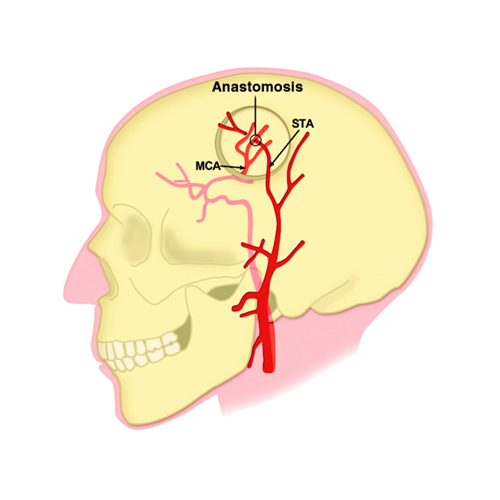Brain Bypass Surgery
Welcome to Snayu, where we provide specialized and advanced care for complex neurological conditions. One of our key procedures is Brain Bypass Surgery, particularly essential for patients with certain cerebrovascular diseases such as Moyamoya disease. This page will offer a detailed overview of brain bypass surgery, its indications, types, procedure steps, and benefits. Additionally, we will address frequently asked questions to help you better understand this crucial intervention.

What is Brain Bypass Surgery?
Brain bypass surgery, also known as cerebral revascularization, involves creating a new pathway for blood flow to the brain. This procedure connects a blood vessel from outside the skull to a vessel inside the brain, bypassing blocked or narrowed arteries, ensuring adequate blood supply to the brain..
Indications for Brain Bypass Surgery
Brain bypass surgery is indicated for patients with various cerebrovascular conditions, including:
- Moyamoya Disease:A rare, progressive condition characterized by the narrowing or blockage of arteries at the base of the brain, leading to the development of tiny, fragile vessels that can rupture and cause strokes.
- Atherosclerotic Cerebrovascular Disease:Severe narrowing or blockage of brain arteries due to plaque buildup.
- Complex Brain Aneurysms:When traditional surgical approaches are not feasible, a bypass can help reroute blood flow.
- Skull Base Tumors:Tumors that affect blood flow to the brain.
Benefits of Brain Bypass Surgery

Restoration of Blood Flow: Ensures adequate blood supply to the brain, reducing the risk of strokes.

Symptom Relief: Alleviates symptoms such as headaches, transient ischemic attacks (TIAs), and seizures.

Improved Quality of Life: Patients often experience significant improvements in daily functioning and overall well-being..

Minimally Invasive: Especially with indirect bypass techniques like EDAMS, which encourage natural vessel formation.
Brain Bypass Surgery Procedure
STA-MCA Bypass Procedure:

- Anesthesia: The patient is placed under general anesthesia.
- Incision and Vessel Identification: An incision is made in the scalp to expose the STA. The MCA is identified within the brain.
- Bypass Creation: The STA is carefully connected to the MCA using microsurgical techniques.
- Closure: The scalp is closed with sutures or staples.
EDAMS Procedure:

- Anesthesia: The patient is placed under general anesthesia.
- Incision and Preparation: Incision is made in the scalp, and the dura mater (the outer membrane covering the brain) is exposed.
- Vessel Placement: The STA is placed directly onto the surface of the brain, and the dura is sewn around it to encourage new blood vessel growth.
- Closure: : The scalp is closed, and over time, new blood vessels develop to provide additional blood flow to the brain.
Some Frequently Asked Questions in Neurology
What conditions are treated with brain bypass surgery?
Brain bypass surgery treats conditions such as Moyamoya disease, atherosclerotic cerebrovascular disease, and certain complex brain aneurysms.
How long does brain bypass surgery take?
The surgery typically takes 3 to 5 hours, depending on the complexity of the procedure and the patient's condition.
What is the recovery time after brain bypass surgery?
Initial recovery usually takes a few weeks, with full recovery taking several months. Patients can expect to stay in the hospital for about 2 to 3 days post-surgery.
What are the risks associated with brain bypass surgery?
Risks include stroke, infection, bleeding, and complications related to anesthesia. However, advancements in surgical techniques have significantly reduced these risks.
How effective is brain bypass surgery?
Brain bypass surgery has a high success rate in restoring blood flow and reducing symptoms, particularly in patients with Moyamoya disease and other cerebrovascular conditions.
Will I need additional treatments after brain bypass surgery?
Some patients may require additional treatments, such as medication to manage risk factors, rehabilitation to aid recovery, and follow-up imaging to monitor blood flow.
What should I expect during the recovery period?
Patients may experience fatigue, mild headaches, and scalp tenderness. It's important to follow postoperative care instructions and attend follow-up appointments.
Can all patients with cerebrovascular disease undergo brain bypass surgery?
Not all patients are suitable candidates. A thorough evaluation by your neurosurgeon will determine if this procedure is appropriate for your specific condition.
What is STA-MCA bypass surgery?
STA-MCA bypass surgery connects the superficial temporal artery to the middle cerebral artery to bypass a blocked or narrowed artery and restore blood flow to the brain.
How is EDAMS different from STA-MCA bypass?
EDAMS involves placing the superficial temporal artery directly onto the brain's surface to encourage new blood vessel growth, while STA-MCA bypass directly connects two arteries.
Visit to make an appointment

Best Multispeciality Hospital in Kolkata
JC-16 & 17, No. 3A, Broadway Rd, opp. to Stadium Gate, Sector 3, Bidhannagar, Kolkata


